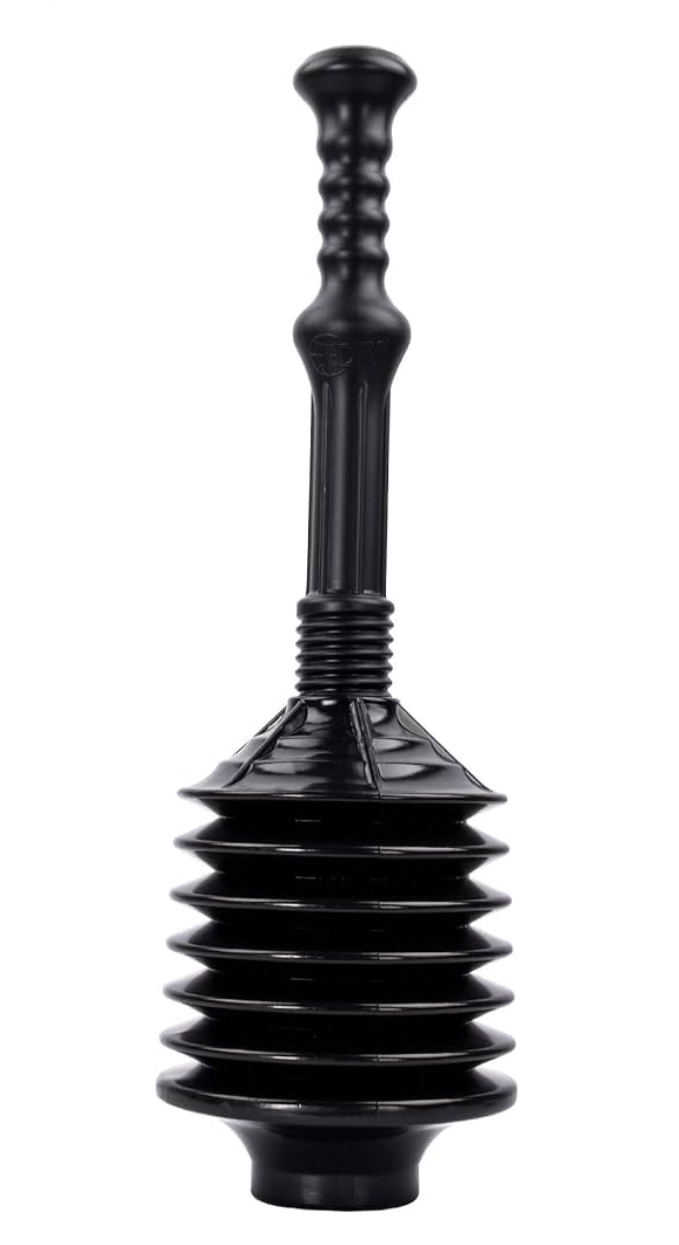I used sink plungers in toilets pretty much my whole life until i scrolled across a similar diagram one day and discovered the truth.
It’s important to have the right-size flange for each hole, yes.
I’ll keep that in mind next time I poop in the sink.
And the bidet’s right there.
Good thinking.
And the sink strainer is there to save and repurpose the corn.
Damn and my kitchen faucet comes with a “power wash” mode. I can’t wait to blast boiling hot water up my butthole. 🤤
It would literally have cost you nothing not to write that sentence down… but here we are
a blistering cleanse
Which brings up a good point; why would anyone need a plunger for a sink? If it gets clogged, nothing will help you short of a drain snake. And if your kitchen sink is getting clogged, it’s time to invest in a garbage disposal.
I’ve found a plunger useful for a sink occasionally, a bit of back and forth plunging can loosen up a hairball or break a layer of fat/soap scum. On the other hand I’ve never needed to use a plunger on a toilet - I don’t know how much of this is exaggeration on the internet but Australian toilets don’t seem to have anywhere near the amount of issues the American designs do.
Plungers certainly do help with sinks. Loosens up a partial clog easily in my experience.
Especially in combination with soda, vinegar and hot water.
Mix in some red food coloring and you’ve got yourself a good time
Especially when it regurgitates back up in your other sink mixed with hair and grime
Soda and vinegar is an odd combination. Soda is a base, making water alkali. Vinegar is an acid, making water acidic. Together, they make water neutral again, with a lot of pretty bubbles.
Either one can work really well depending on the stuff you need to get rid of. But adding one to the other just weakens it.
I do this for a living. If you really wanna save yourself some money, depending on your plumbing(usually PVC, older houses might have cast iron), just put a bit of a cleaning agent and run hot water into your drain for 10-20 minutes weekly. The hot water alone every week will do more for your pipes in the long run.
If you’re doing this regularly you won’t have to run the water as long, maybe 5 minutes weekly. This helps to dissolve build up from stuff like grease and soap scum which catches other food debris and leads to clogs. Preventive maintenance is best, spend a little time and money now to save a lot of time and money later.
Mixing them together causes an exothermic reaction that releases a lot of CO2. Both the heat and the releasing of gas bubbles can also help to break up things. Also it’s unlikely that all will mix with all, so you get some pockets of basic and some pockets of alkaline, who knows what you’re trying to break up but some of either might help. The method they learned is kind of throwing everything at it cus something will work. You aren’t wrong, both methods have validity
Hmm, it seems to me most of those bubbles will happen not where you need them. Maybe if you throw in the base first and the acid later (or the other way around)
And the exothermic reaction is really weak. Barely gets warm.
So weird. It always seems to pump air through the overflow and do no good. By the time you figure out how to plug the overflow, you might as well have taken off the trap and emptied it in the trash …… especially with PVC traps where it all just comes apart without tools
Many sinks do not have overflow drains.
I just put my hand over the hole, takes two seconds. And I don’t have to clear out under the sink and get a bucket. (And it’s only very rarely necessary)
This is true for sure. You can definitely use either in either situation if you have to.
not at all effectively.
flanged plungers typically dont fit sink drains and will deform upon compression, and sink plungers dont create enough of a vacuum seal in the toilet outtake to be of much use without a lot of unnecessary effort and mess.
True but you can make it work if you have no choice.
in situations where the clog is mild, sure.
If the clog is severe, then you’ll make little and often no headway using a flanged plunger on a sink drain or a sink plunger on a toilet, no matter how long and frantically you thrust away and splash about.
the flanged plunger isn’t rigid enough to create the necessary vacuum or pressure in a sink and the sink plunger doesn’t create a tight enough seal to create the necessary pressure in a toilet unless the clog is mild in the first place.
My new toilet doesn’t fit either of the above shapes, but a “Beehive” plunger works great. The toilet also flushed really well and hasn’t gotten plugged up even once yet, but I made sure to have one that would work as soon as the toilet was ready to use.
My new toilet doesn’t fit either of the above shapes, but a “Beehive” plunger works great.
https://www.korky.com/parts/plungers/beehive-max-toilet-plunger
The toilet also flushed really well and hasn’t gotten plugged up even once yet, but I made sure to have one that would work as soon as the toilet was ready to use.
What’s different between the beehive flange and the toilet plunger flange? they look the same.
or perhaps I should ask what shape is your toilet?
I now just imagine them having a hexagonal toilet.
Hahaha, this must be it.
(USA) - I had the same issue as the user above - due to high edficiency toilet. The opening is more rectangular/ elongated than a normal toilet’s circular opening.
Why did a regular one not fit?
Basically, it’s shaped weird and won’t make a seal. It’s a WaterSense toilet that flushes very efficiently with 1.28 gallons, with an unusual configuration of input/output under the water. Almost like a channel from front(ish) to back. If you try to use a plunger like those pictured, part of the channel isn’t covered, so you just push water back out into the bowl. Good thing I was trying it with a clean new toilet! The wide deep beehive shape lays rubber all into the space, pushing the water down into the exit hole.
Until they start stiffening with age.
Usually age has the opposite effect, but I hear they make pills for that.
The epdm mine is made of is quite stiff after about 10 years of use
They’re talking more like 40 or 50 years. You’ve got plenty of time
Lkke i said mine is already stiffening after 10 years. Its almost like hard plastic now
This little bad boy here has changed my life.
I refuse to acknowledge someone is plunging enough to have their life changed by a plunger. Unless you’re using that thing to do whipits.
Ha ha. No no. I’m pretty good. No problems with the old downstairs plumbing. But it’s not just for toilets. It’s for bathtub sinks clogged with hair. Kitchen sinks, etc… It’s just handy to have around the house. I even used it once to blow the dust out of my dryer vent.
Haha, that commercial is very funny, but it actually works?
is it shooting compressed air?
it has a 12 shot magazine?
I don’t quite understand what it is.
It’s essentially a handheld air cannon. The kit comes with a handle and a suction that covers the toilet hole or whatever. You press down and yeah…it’s basically a air-gun shot to the clog.
And yeah. It works great. Not always on the first blast. But I’ve never had it fail me.
awesome, good to know about.
Why has no one mentioned this style? I’ve had one for years, and there’s never been a clog it couldn’t fix.

They’re too Giger.
the regular toilet plungers also have a flange and work every time without implanting xenomorphs in your chest cavity.
They sell these in dollar stores here.
I didn’t have to unclog a sink for years and didn’t own a plunger. I was looking for a “classic one” but they only had these and I wasn’t sure. I gave it a try anyway and to my surprise, it was very efficient.
Never tried on a toilet and I suspect it would work fine too, but I tried it on my bathtub drain and unfortunately it fails to make a seal.

I agree, although the plastic will crack /split along one of the folds eventually, rendering it unusable
Still, that style is my goto
Why do you have a man-portable Tesla Coil as a plunger?
often, the toilet plunger will look like a sink one on the shelf because they pushed the flange up inside
Most plungers are both. Pull down the cone for the commode or push it up inside for the sink.
Who uses the same plunger for the toilet and kitchen sink?
I guess the kind that actually cleans the plunger after use. When I have to use one, after use, I take it outside and hose it off with the hose pipe then soak it in a bucket of bleach water.
I just rinse off the plunger in the new toilet water. Never had an issue.
Plus you can do a double check flush to make sure it’s all clear.
The sink is one of the easiest areas of your house to clean with soap and water.
What kind of maniac uses it in a sink after using it in a toilet?
Clean it first. Then clean the sink after using soiled plumbing tools.
Just buy a new sink after you unclogged it.
y’all motherfluffers never heard of bleach
I have to finish Attack on titan first.
I prefer not to put my hand on the business end of the doodie derby rod, thank you very much
I wonder what the history of this was, and why I never knew about this.
Was there always such a distinction? Did it apply to older toilets as well? Were all my parents, relatives, friends parents just cheap and got the wrong one?
I have only seen one in a commercial bathroom and I just assumed it had to do with those industrial shaped toilets they use.
I have IBS so that’s saying a lot.
“Was there always such a distinction?”
No, The first cup plunger was invented as the flushing mechanism in 1777, since the flushing toilet wasn’t invented until almost 1800.
that one looked pretty similar to cup plungers of today.
As far as I can find, accordion and flange plungers were developed later to accommodate the standardized outtake valves of modern toilets.
“Did it apply to older toilets as well?”
Yup, except the first cup plunger was held like a hammer rather than a plunger is held today.
“Were all my parents, relatives, friends parents just cheap and got the wrong one?”
Mine certainly were, and again, this design difference is for some reason not common knowledge, so it’s more likely they just didn’t know that the flanged plunger is specifically made for toilet drains.
Someone watches reddit stories on smosh
Sorry, not this guy. I’ve never seen smosh.
This is wrong. Some toilets use the normal “sink” plunger because the exit opening is too large for the “toilet” marked style. You get either or whatever fits your toilet. It’s not specifically for sink only.
Not at all.
“You get either or whatever fits your toilet. It’s not specifically for sink only.”
Incorrect.
The cup plunger is designed to fit over drains on flat surfaces, while flanged plungers are designed to fit inside the outtake valves of toilets.
“Some toilets use the normal “sink” plunger because the exit opening is too large for the “toilet” marked style”.
This is also wrong because:
- The flange is as wide as a cup plunger for sinks anyway, so a sink plunger won’t work if a toilet outtake is too wide for a toilet plunger, and
- the toilet plunger is made to fit inside the outtake of the toilet, not over the mouth of the drain like a cup plunger.
they are completely different designs and have different use-cases that you will only give you and others more trouble and mess for by not knowing and spreading misinformation.
I am not wrong. There are toilet designs where the flange style literally doesn’t cover the exit chute. I have one. I have to use a “sink” style type. The flange style is small and does not form any type of seal due to the shape and size. It’s literally impossible that it is the correct solution. Everything I said is 100% correct.
you are wrong.
“There are toilet designs where the flange style literally doesn’t cover the exit chute.”
The flange is not designed to cover the exit chute, but rather to fit inside the outtake.
This is also apparently due to your specifically atypical plunger.
“The flange style is small and does not form any type of seal due to the shape and size”
since flange and cup plungers are the same diameter, you are clearly having an anomalous problem that you should not be drawing broad conclusions from.
cup plungers and flange plungers are specifically designed to address different problems, to be used in different manners(the cup covers a uniform drain on a flat surface while the flange creates a seal within the sloped and curved toilet outtake by fitting inside the outtake) and are not interchangeable.
Your premises are flawed and your conclusions are incorrect.
Literally don’t give a shit what you say. I am not wrong. On this specific toilet, the flange style literally doesn’t seal and CANNOT perform a push / pull to unclog a drain due to the exit profile and shaping.
You are not right no matter how smart you think you are.
You are arguing that a baseball cap works equally as well as putting a sneaker on your head.
It doesn’t, because while a sneaker is designed and meant to cover your foot, a baseball cap is designed and intended to cover your head.
A sneaker makes an ineffective ballcap and a ballcap makes an ineffective shoe.
Two separate items with separate designs and use-cases.
I think you are failing to understand the design / curvature / multiple radius features of the exit point and that the flange style literally cannot form any remotely close to passable seal to do its job. Idk what to tell you but your not right no matter how you think you can phrase it.
My favorite with the flanged is all the shit that gets caught inside and splashes when you lift it out the water.
Babe quick, new toilet lore just dropped!
skibidi?
About 250 years old, thinking it’s new is why I wanted a YSK post.
yeah but I feel…
always had the left style ‘sink’ plungers growing up. they unclogged the shitter just fine.
Absolutely never, ever tried using a plunger on the sink. I guess our family didn’t clog the sinks so much? what’s clogging these sinks that they justify a plunger?
If you clean a fish and toss a couple scales and fish skin down the sink, it will clog.
in the states, where houses have garbage disposals, I don’t think sink clogs are much of a problem anymore.
but most countries don’t have garbage disposals, and the original plunger design was invented 250 years ago, before much of modern plumbing and pipe design and everything, so it was useful to have any kind of plunger around.
you can make those couple plungers work for the toilet in a lot of situations, but for the toilet specifically a toilet. plunger is going to make your job way easier without any mess and splashing
yeah I have a disposal that will eat bones. never clogged the sink.
Was the og design for shitters or sinks?
Never had splash issues, I generally plunge pretty cautiously.














